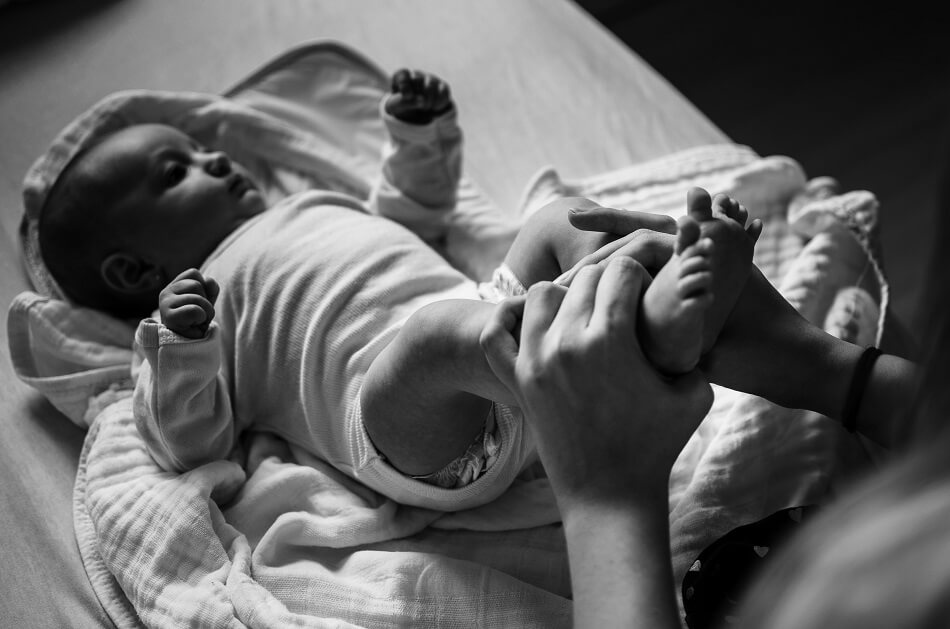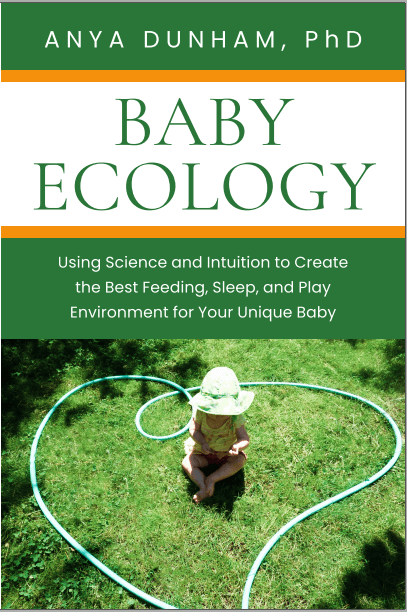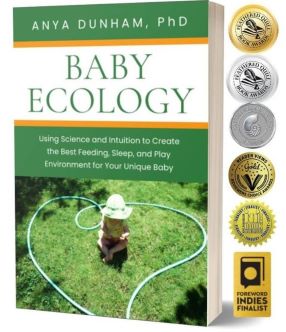Baby Ecology book is here! Learn more
Baby Ecology book is here!
- Home
- Getting Ready Checklist
- Attachment and mind-mindedness
How to build attachment and bond with your baby using mind-mindedness
by Anya Dunham, PhD
Wondering about how to build attachment with your baby? Mind-mindedness can help; most parents have never heard of it, but many practice it intuitively.

(Updated on February 3, 2024)
Your baby will be
ready to connect and form relationships as soon as they are born. According to the theory of attachment, each baby needs to have at least one person with whom they have a strong and mutual emotional bond.1 Many parents wonder about how to build attachment with their baby from the very early days.
Secure attachment is more than just techniques
The idea of attachment is important, but often misunderstood. Some books and online resources present secure attachment as physical attachment. They view attachment parenting as a set of specific practices and techniques like babywearing, bed-sharing, and breastfeeding.
Some or all of these techniques may fit beautifully into your family. But techniques do not necessarily equal attachment. Attachment is the quality of your relationship with your baby, not the techniques you use.
Attachment = relationship quality
How to build attachment
Research shows that secure attachment forms best when parents are sensitive and mind-minded.
Sensitivity is probably not a new concept for you. Sensitive parents try to interpret their baby’s signals accurately and respond promptly and warmly. They help their baby regulate emotions and provide a sense of safety: a secure base to explore the world from.
But have you heard of mind-mindedness?
Mind-mindedness, and why it matters
Mind-mindedness is a certain way parents see even very young babies: not only as little bundles of joy and potential, but as people with minds, thoughts, and feelings of their own.2 They know that babies are tuned in right from the start. Mind-minded parents notice and consider their baby’s emotions, sensations, and needs. They adjust their views and practices as they watch their baby’s behaviour, instead of relying on pre-conceived notions, their own feelings and wishes, or general ideas of what babies need or should be doing.3
Mind-minded parents tend to use mind-related comments when they are with their babies. Their comments might:
- Accurately reflect baby's emotions, intentions, or interests (“You seem very interested in my watch”)
- Link current event with similar events from the past (“Do you remember seeing a cow when we went to the farm?” - when the baby plays with toy cow)
That being said, not making appropriate mind-minded comments does not necessarily point to the absence of mind-mindedness: some parents don't verbally reflect but still appreciate their baby’s internal states and show this through non-verbal actions.4 If you're an introvert, this might ring the bell. (Here is another reason to label actions and emotions in the moment though.)
Why mind-mindedness matters
The very first paper describing mind-mindedness was published in 1997.5 Over the following 25 years a number of studies have been completed, and collectively they show that mind-mindedness makes a difference:
- Babies whose parents are mind-minded tend to have a better physiological capacity to regulate their emotions.6,7 In other words, it is easier for them to stay calm, and to return to a calm state.
- Parents who are able and willing to treat babies as people with minds tend to be more “tuned into” their babies' cues and more likely to interpret the cues accurately which increases sensitivity and responsiveness and, through that, helps build secure attachment.8
- Mind-mindedness enhances mutual responsiveness (warmth, cooperation, and affection) between toddlers and their parents.9
- Children who grow in mind-minded environments learn to speak earlier and recognize and understand emotions and needs of people around them better.10-12
- Interestingly, dads' mind-mindedness appears to also uniquely contribute to toddlers' self-regulation in difficult-for-toddlers tasks, such as waiting. Dads tend to be more stimulating when playing with young kids; it might be that when they take their kids close to, but not beyond, the limits of their comfort zone, while - and this is a crucial piece 💡 - being attuned to kids’ thoughts and emotions, kids practice self-control in small, incremental ways and develop self-regulation.7,9
- Last but not least, mind-mindedness directly fosters secure attachment in toddlerhood, preschool years, and beyond.4,8 The longest longitudinal study to date followed 102 babies and their families from 7 months to 10 years old; 10-year-olds in mind-minded families were more likely to have a ”special, tension-free, trusting, and comfortable connection" with their parents.8 How wonderful is that?
How to practice mind-mindedness
Being mind-minded is naturally easier for some people than others. Some adults spontaneously characterize other people in terms of their thoughts, feelings, intentions, and motivations, whereas others focus more on physical appearance or general behavioral tendencies.13 But the good news is, mind-mindedness absolutely can be learned and practiced.14
I like to think of mind-mindedness as tuning in, seeing baby as a complete, whole person with a mind of their own, and considering baby’s perspective.
~ Mind-mindedness before your baby arrives
You can begin practicing mind-mindedness as you prepare for your baby's arrival. Next time you are around a baby or a young child, ask yourself how they may be feeling or what they might be thinking. This is often easier to do when you don’t know the child; when you do know them, their likes, dislikes, or their appearance might come to mind first:
“She is always so active”;
“He is such a good eater”;
“What a cute baby”.
But to practice mind-mindedness, try to focus on what the child may be feeling or thinking in this moment:
“She might be overtired”;
“I think he is really enjoying apple sauce”;
“This baby seems fascinated by the balloons”.
~ How to be mind-minded with your baby
Once your baby is here, you can practice mind-mindedness during the daily care routines. Think about how you could do things with your baby rather than to him.
In the early days, tell your baby what you are about to do: “Let’s change your diaper. I am going to carry you to the changing table”.
Being talked to during care routines calms babies. In one study, newborn babies were massaged by a caregiver who made eye contact, spoke soothingly, and rocked them gently afterwards – and babies' stress hormones decreased. But when babies were massaged in silence and without eye contact, their stress hormones surged. In fact, they had stress hormone levels similar babies undergoing painful medical procedures! 15

Another way to practice mind-mindedness is simply being with your baby. Hold your baby or lie down next to her and watch her quietly. Try not to think about what you want her to do or what the charts say she is supposed to be doing at this age. Don't actively engage your baby. Try to simply see her in the moment, as she is. Notice what she is looking at, what she is working on, and what might be hard for her. Infant specialist Magda Gerber called this way of being with babies "wants nothing quality time" (wonderfully explained here by Janet Lansbury).
You will not always know what your baby needs; that would be impossible. But try putting yourself in your baby’s shoes as much as you can. It will become easier as you get to now her better, and as she grows.
You might also be interested in:
References
References
1. Ainsworth MS, Bowlby J. (1991) An ethological approach to personality development. American Psychologist 46(4):333-41
2. Meins E, Fernyhough C, Arnott B, Turner M, Leekam SR. (2011) Mother- versus infant-centered correlates of maternal mind-mindedness in the first year of life. Infancy 16(2):137-65
3. Koren-Karie N, Oppenheim D, Dolev S, Sher E, Etzion-Carasso A. (2002) Mothers' insightfulness regarding their infants' internal experience: Relations with maternal sensitivity and infant attachment. Developmental Psychology 38(4):534-42
4. Zeegers MAJ, Colonnesi C, Stams G-JJM, Meins E (2017) Mind matters: A meta-analysis on parental mentalization and sensitivity as predictors of infant-parent attachment. Psychol Bull 143(12): 1245-1272
5. Meins E (1997) Security of attachment and the social development of cognition. Hove: Psychology Press
6. Zeegers MAJ, de Vente W, Nikolić M, Majdandžić M, Bögels SM, Colonnesi C. (2018) Mothers’ and fathers’ mind-mindedness influences physiological emotion regulation of infants across the first year of life. Developmental Science 21(6):e12689
7. Nikolić M, Zeegers M, Colonnesi C, Majdandžić M, de Vente W, Bögels SM (2022) Mothers' and fathers' mind-mindedness in infancy and toddlerhood predict their children's self-regulation at preschool age. Dev Psychol 58(11): 2127-2139
8. Miller JE, Kim S, Boldt LJ, Goffin KC, Kochanska G (2019) Long-term sequelae of mothers' and fathers' mind-mindedness in infancy: A developmental path to children's attachment at age 10. Dev Psychol 55(4): 675-686
9. Bendel-Stenzel LC, An D, Kochanska G (2024) Elucidating mechanisms linking mothers' and fathers' mind-mindedness in infancy with children's self-regulation at early preschool age. J Exp Child Psychol 238: 105782
10. Goffin KC, Kochanska G, Yoon JE (2020) Children's theory of mind as a mechanism linking parents' mind-mindedness in infancy with children's conscience. J Exp Child Psychol 193: 104784
11. Meins E, Fernyhough C, Johnson F, Lidstone J. (2006) Mind-mindedness in children: Individual differences in internal-state talk in middle childhood. British Journal of Developmental Psychology 24(1):181-96
12. Farrow C, Blissett J. (2014) Maternal mind-mindedness during infancy, general parenting sensitivity and observed child feeding behavior: a longitudinal study. Attachment & Human Development 16(3):230-41
13. Meins E, Fernyhough C, Harris-Waller J (2014) Is mind-mindedness trait-like or a quality of close relationships? Evidence from descriptions of significant others, famous people, and works of art. Cognition 130(3): 417-27
14. Larkin F et al (2019) Proof of concept of a smartphone app to support delivery of an intervention to facilitate mothers' mind-mindedness. PLoS One 14(8): e0220948
15. White-Traut RC, Schwertz D, McFarlin B, Kogan J. (2009) Salivary cortisol and behavioral state responses of healthy newborn infants to tactile-only and multisensory interventions. Journal of Obstetric, Gynecologic & Neonatal Nursing 38(1):22-34
Using hundreds of scientific studies, Baby Ecology connects the dots to help you create the best environment for sleep, feeding, care, and play for your baby.
Warmly,
Anya


